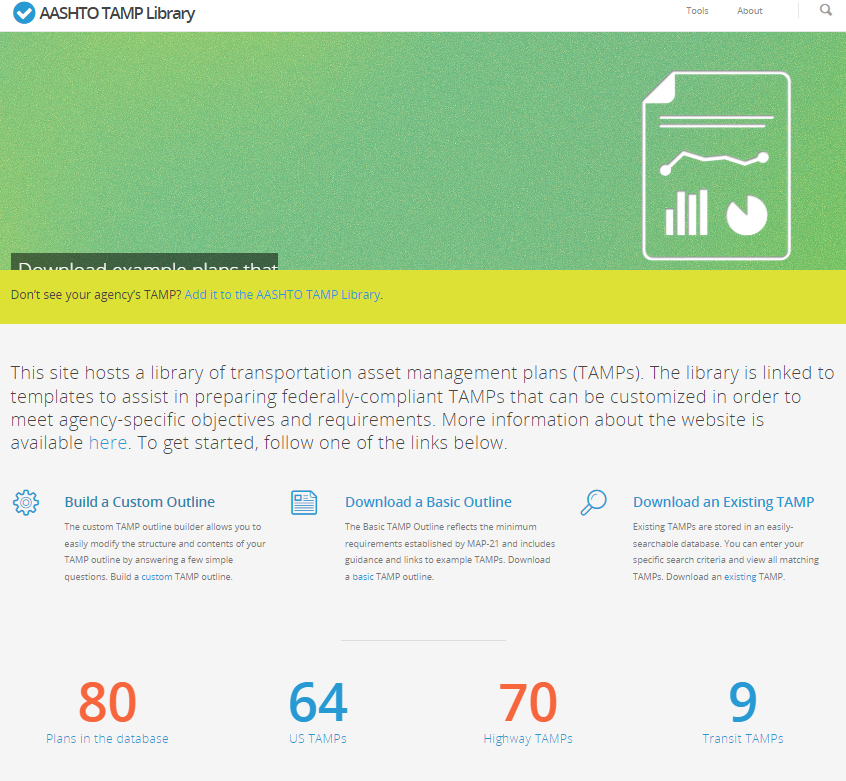- Chapters
-
Chapter 2
Sections - Chapter 2 Home Page
- Chapter PDF
Chapter 2
Quick Links
2.4.2
Beyond the Basic TAMP
This section contains suggestions for developing a TAMP that goes beyond the basic elements of a TAMP described in the previous section. An agency can expand the scope of the TAMP to include additional asset types and systems. An agency may further tailor their TAMP to address specific needs.
TAMP Scope
A highway agency focused on complying with Federal requirements will typically focus on including its NHS pavements and bridges in its TAMP. While these assets make up the greatest portion of a typical state highway agency, an agency may wish to include additional assets in its TAMP. Also, the agency may wish to extend the network scope of the TAMP. In updating a TAMP with NHS pavement and bridges, an agency may include other assets, such as drainage assets, traffic and safety features, or the agency may wish to include all of the assets it owns.
For transit TAMPs, the initial focus is on revenue vehicles, facilities and infrastructure, as these are the assets that require the greatest investment. An agency may wish to expand its TAMP to include additional assets that are important to the systems, albeit less costly, such as bus shelters and signage.
TAM Webinar #55 - TAM Tools Miniseries 02: Management Systems
TAM Implementation Plan
As described in Section 2.3, it is often helpful to prepare an implementation plan describing a set of planned business process improvements that an agency intends to undertake to strengthen its approach to TAM. There are many examples of TAMPs that focus specifically on an agency’s TAM approach and how it plans to improve its approach. Ideally a TAMP should both describe an agency’s assets and planned investments, and detail how it intends to improve its TAM approach. Where an agency has developed both a TAMP and TAM implementation plan, the implementation plan can be incorporated as a section of the TAMP.
TAM Guide Book Club #2: TAMP Implementation and Integration
TAM-Related Business Processes
An agency may wish to include a discussion of one or more of the business processes related to TAM in its TAMP. Alternatively, there may be other agency documents that provide more detail on these issues that can be referenced in the TAMP. These areas include:
- Performance Targets. As described in Chapter 5, setting performance targets can help guide the resource allocation process. However, agencies often have broader efforts to establish and track performance beyond the scope of TAM.
- Financial Planning. While developing a TAM investment plan is central to developing a TAMP, often the revenue forecast used to support developing the investment plan is developed separately and used for other purposes beyond the scope of TAM. It may be valuable to document the agency’s approach to forecasting future revenues for TAM and other applications. Chapter 5 describes provides additional detail on this topic.
- Work Planning and Delivery. As described in Chapters 4 and 5, work delivery approaches can impact how assets are maintained over their life cycle, and how resource allocation decisions are made. Some agencies have adopted formalized approaches for evaluating and selecting different work delivery approaches.
- Data Management. Chapter 7 discusses the importance of implementing an approach to data management and governance. Some TAMPs include additional information on this topic given its relationship to TAM.
AASHTO
The AASHTO TAMP Builder website (available at https://www.tamptemplate.org/) hosts annotated plan outlines to assist agencies in preparing TAMPs. The site also provides resources to customize an outline in order to meet agency-specific objectives and requirements. The website integrates a database of TAMPs, dating from 2005, that support the functionality of the outlines created using the site.
Use this Site to Build a MAP-21-Comlpiant TAMP

